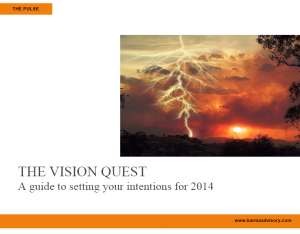3 Steps To Creating Your 2014 Resolutions - Mindfully
A man once asked the Dalai Lama, “I want to be happier, what should I do?”

The Dalai Lama simply replied, “Write down what makes you happy, do more of those things; write down what makes you unhappy, do less of those things.”
At the end of any year, we have the opportunity: to look at the mud and look at the beauty from the past year.
If we do this well, we can truly begin anew with our selves – we can give ourselves a chance to feel the experiences of the past year, to extract all the wisdom we can from those experiences, and use them to plant the seeds for the next year.
How and when should I do this?
The end of the year is a great time – even on New Year’s eve! Of course, this can be done any time; but the idea is to set up your new year with a brand new energy, intention and focus. Get comfortable, meditate for 30 minutes, find some relaxing music, or whatever works to get you in a state of reflection and writing.
Speaking these things out loud or just thinking them does you no good — you need to do the work of writing them out, so you can externalize and witness the story of your experiences.
Below are some shortened exercises; the full version can be found in our gift to our friends, family and loved ones, ‘The Vision Quest – A guide to setting your intentions for 2014′.
Step 1: Understand your emotional state. Understanding our emotional layer is the key to defining who we are and what our next steps should be. We may have an outer façade of calm and cool; but within us, we are swirling with different feelings, which need to be expressed, or witnessed, or dealt with. Looking at these feelings, without judging them, but just experiencing them and naming them as necessary, is a core part of our personal mastery.
Even great Zen teachers, leaders and masters have emotions; and many times, these emotions are channeled into their own life lessons and actions they take to become better individuals. According to Tony Robbins, emotions are the fuel of life and our actions – they form a core part of our vitality.
Step 2: Take stock of your year What happened this year? Take a look at all your milestones/experiences this year, by looking at journal entries, pictures, etc. Don’t get lost in the stories or reliving them (or creating action check lists!), just write them out. Include areas of family, friends, relationships, and career. What were your highlights – good or bad; small or large – for the past year. Write everything out that occurred this year.
What went well this year? What made you happy? Review your list of events from this year, reflect and embody the experience. What made you happy? Was it the achievement of a goal? Was it spending time with loved ones? Was it letting go of something?
What didn’t go well this year? What made you unhappy? Review your list of events from this year, reflect and embody the experience. What made you unhappy? When did you feel sad? Depressed? Anxious? Write everything out that occurred this year.
Step 3: Create your intentions for 2014
Intentions are different from goals. Goals are considered ‘SMART’ – Specific, Measurable, Attainable, Relevant and Time-bound. Goals can be used by the ego to keep you ‘in check’, and it is also a success/failure-oriented way of thinking. We use outer goals to measure our outcomes against ourselves and society, to see if we’re making progress. In reality, outer progress is very different from inner progress.
Intention, which is what we would focus on, is more in line with universal laws – and helps determine our mindset, our way of being, and attitude towards life. We are able to manifest even greater things by having clear and focused intentions.
I like to look at life as 30 or 90 day experiments. All of our intentions can be aligned with this timeframe, as it allows us to keep growing and evolving our abilities, mindset and possibilities over time.
For example, my intention may be to eat in a healthier manner, in order to lose weight or feel more vital. Setting a goal would be of losing 50 lb in 3 weeks. What is more worthwhile is to set up practices which would align with the intention, and monitor our ability or will-power to follow through with the practices (and adjust over time!). In this case, my practices to support my intention would include reading on good eating habits, finding time to exercise daily, avoiding certain foods and shopping for organic fruits and vegetables once a week.
Please take a moment to come up with a few intentions and practices in each of the areas below for the next year. This exercise was inspired by Wharton Professor Stew Friedman’s book, ‘Total Leadership’.

More guidance around the exercises, and other questions/checklists, can be found in THE VISION QUEST - A guide to setting your intentions for 2014 (Shared with all in the spirit of the gift economy :)
Posted by Sarika Jain on Dec 31, 2013



On Dec 31, 2013 Yoo-Mi Lee wrote:
Post Your Reply